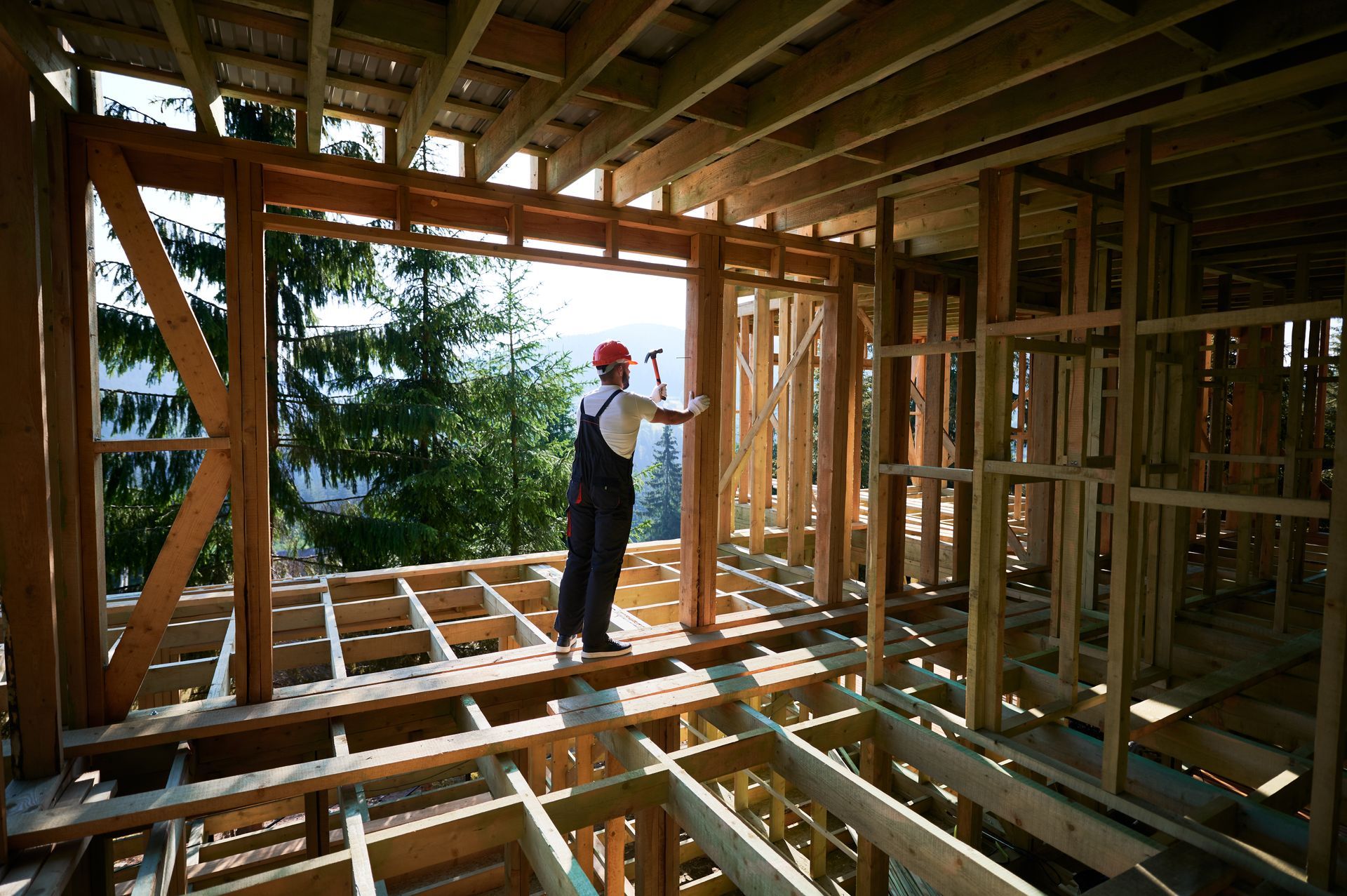Builder's Risk Insurance For Contractors

See How We're Different:
or call us: 619-719-5818
Top 3 Recommended Policies
Index
Contact Us
Phone
Location
As a contractor, understanding the complexities of insurance is vital to protecting your investments and ensuring the success of your projects. One particular type of insurance that plays a critical role in the construction industry is Builder's Risk Insurance. This guide delves into its definition, coverage, cost, and much more, equipping you with essential knowledge for your contracting journey.
Understanding Builder's Risk Insurance
Definition and Importance of Builder's Risk Insurance
Builder's Risk Insurance, also known as Course of Construction Insurance, is a specialized policy designed to cover buildings and structures during the construction phase. This insurance typically protects against risks such as fire, theft, vandalism, and adverse weather conditions that can cause damage to a building under construction.
The importance of Builder's Risk Insurance cannot be overstated. It provides peace of mind that your investment is secured during a time when it is most vulnerable. As construction often involves significant financial resources, having appropriate coverage is essential to mitigate potential losses. Without it, contractors could face enormous out-of-pocket expenses in the event of unforeseen incidents. Additionally, many lenders require Builder's Risk Insurance before they will finance a construction project, making it not only a safeguard for the builder but also a necessity for securing funding. This requirement underscores the critical role that this insurance plays in the construction industry, ensuring that projects can proceed without unnecessary financial risk.
Key Features of Builder's Risk Insurance
Builder's Risk Insurance policies come with various key features that cater specifically to the needs of construction projects. Generally, these policies offer coverage for:
- Physical damage to the structure under construction
- Materials and supplies on-site
- Temporary structures, such as scaffolding
- Landscaping and outdoor improvements
- Soft costs arising from delays due to covered perils
Every policy may vary, so it’s essential to read the terms carefully to understand what is covered and what is not. Moreover, some policies may also include coverage for equipment and tools that are essential for the construction process, which can be particularly valuable for contractors who rely on expensive machinery. Furthermore, Builder's Risk Insurance can often be tailored to the specific needs of a project, allowing for customization based on the type of construction, the location, and the duration of the project. This flexibility ensures that builders can find a policy that aligns with their unique circumstances, providing comprehensive protection against a variety of potential risks.
Who Needs Builder's Risk Insurance?
Identifying the Right Professionals for Builder's Risk Insurance
Builder's Risk Insurance is crucial for various professionals involved in construction projects. This includes general contractors, construction managers, subcontractors, and even homeowners who are acting as their own general contractors. Each party should consider obtaining this insurance to protect their interests and investments. Additionally, stakeholders such as lenders and investors often require proof of Builder's Risk Insurance before funding construction projects, making it a necessary component of the overall financial plan.
In addition to the primary contractors and homeowners, other professionals such as architects and engineers may also benefit from Builder's Risk Insurance. While they may not be directly involved in the physical construction, their designs and plans are integral to the project’s success. If unforeseen circumstances arise that cause delays or damage to the project, having this insurance can safeguard against potential financial losses that could impact their reputation and future work. Moreover, real estate developers, who often juggle multiple projects at once, should also consider this insurance to mitigate risks across their portfolio and ensure that their investments are adequately protected.
The Role of Contractors in Builder's Risk Insurance
Contractors play a pivotal role in overseeing construction projects, and their responsibility extends to ensuring adequate coverage is in place. They should evaluate the specific needs of the project and work with insurance providers to determine the appropriate coverage limits and policy features. This includes considering factors such as the project's location, the materials being used, and the overall timeline, as these elements can significantly influence the risk profile of the project.
Furthermore, contractors should maintain open communication with all stakeholders about the insurance coverage, ensuring everyone understands what is protected under the policy. This collaborative approach not only fosters trust but also leads to a smoother project workflow. Regular meetings can be scheduled to discuss the insurance terms and any changes that may arise during construction. Additionally, contractors should educate their teams about the importance of adhering to safety protocols and best practices, as this can help minimize risks and potentially lower insurance premiums. By taking a proactive stance on risk management, contractors can enhance the overall stability of the project and contribute to its successful completion.

Coverage of Builder's Risk Insurance
What Does Builder's Risk Insurance Cover?
Builder's Risk Insurance typically covers a wide array of risks associated with the construction process. This includes, but is not limited to:
- Fire damage
- Wind and hail damage
- Theft of materials and equipment
- Vandalism
- Accidental discharge of water
In many cases, policies can be tailored to include additional coverage options based on the unique risks of a specific project, making it essential for contractors to discuss their needs with insurance professionals. For instance, if a project is located in an area prone to severe weather conditions, additional coverage for storm-related damages may be advisable. Furthermore, some policies can also extend to cover soft costs, such as lost income due to project delays, which can be a significant financial burden for contractors and developers alike.
Moreover, Builder's Risk Insurance can also encompass coverage for materials that are stored off-site, which is particularly beneficial for larger projects where materials may be delivered in phases. This aspect of coverage ensures that contractors are protected against potential losses during transportation or while in storage, thereby safeguarding their investment in materials and supplies. Understanding these nuances can significantly enhance a contractor's ability to manage risks effectively throughout the construction process.
Limitations and Exclusions of Builder's Risk Insurance
While Builder's Risk Insurance provides robust protection, it is crucial to be aware of its limitations and exclusions. Standard exclusions may include:
- Loss due to wear and tear
- Intentional damage
- Earthquake or flood damage (may require separate policies)
- Employee injuries (covered under worker's compensation)
Contractors should remain vigilant in understanding these limitations to avoid any surprises when filing a claim. Consulting with an experienced insurance agent can also clarify policy details and exclusions. It's also important to note that some policies may have specific requirements regarding security measures for the construction site. For example, if a site is left unattended for an extended period, the insurer may require the installation of security cameras or fencing to mitigate theft and vandalism risks.
Additionally, certain types of construction projects may have unique risks that are not covered under standard Builder's Risk Insurance policies. For example, projects involving high-rise buildings or complex structures may require specialized coverage to address the unique challenges and hazards associated with such constructions. Therefore, thorough communication with the insurance provider is essential to ensure that all potential risks are adequately addressed and that the coverage aligns with the project's specific needs.
Cost of Builder's Risk Insurance
Factors Influencing the Cost of Builder's Risk Insurance
The cost of Builder's Risk Insurance can vary widely based on multiple factors. Key elements that influence pricing include:
- The value of the project being insured
- The location of the construction site
- The duration of the coverage
- The type of materials used in construction
- The level of risk associated with the project
Understanding these variables allows contractors to find coverage that aligns with their budget while still providing the necessary protection. For instance, projects located in areas prone to natural disasters, such as hurricanes or floods, may attract higher premiums due to the increased likelihood of claims. Similarly, high-value projects that utilize expensive materials, like custom woodwork or high-end finishes, will typically incur higher insurance costs. Additionally, the construction timeline plays a critical role; longer projects may require extended coverage, which can further impact the overall cost.
Moreover, the contractor's experience and claims history can also affect pricing. Insurers often consider the track record of the builder when determining risk levels. A contractor with a history of successful projects and minimal claims may receive more favorable rates compared to one with a history of frequent claims. This highlights the importance of maintaining a good reputation and demonstrating reliability in the construction industry.
Tips to Reduce the Cost of Builder's Risk Insurance
Reducing the cost of Builder's Risk Insurance does not mean sacrificing coverage quality. Here are several practical tips to help contractors save on insurance premiums:
- Shop around and compare quotes from multiple insurance providers.
- Increase the deductible to lower the premium costs.
- Work with a reputable insurance broker who understands the construction industry.
- Implement risk management practices on-site to demonstrate lower risk to insurers.
Employing these strategies can lead to significant savings that can be redirected towards other essential project needs. Additionally, contractors should consider bundling their Builder's Risk Insurance with other types of coverage, such as general liability or workers' compensation, to take advantage of multi-policy discounts. Many insurance companies offer reduced rates for clients who consolidate their policies, which can result in substantial overall savings.
Furthermore, staying informed about industry trends and changes in insurance regulations can also help contractors make better decisions regarding their coverage. Engaging in continuous education about risk management techniques, such as safety training for workers and regular site inspections, not only enhances the safety of the project but can also lead to lower insurance costs. Insurers are more likely to offer favorable rates to contractors who actively take steps to mitigate risks on the job site.
Claiming Builder's Risk Insurance
When and How to File a Claim
Understanding when and how to file a claim under your Builder's Risk Insurance policy is critical in effectively managing this type of insurance. Claims should be filed promptly when damage or loss occurs. The claims process generally involves the following steps:
- Document the damage through photographs and detailed notes.
- Notify your insurance provider as soon as possible.
- Complete any necessary claim forms provided by your insurer.
- Provide any required documentation, such as receipts or invoices.
Prompt action can assist in expediting the claims process and ensuring that you receive any due compensation quickly. Additionally, it is advisable to keep a separate file for all communications with your insurance provider, including emails and phone call notes. This organized approach not only helps in tracking the progress of your claim but also serves as a valuable reference in case of any disputes that may arise during the claims process. Furthermore, understanding the specific terms and conditions of your policy can empower you to advocate for your rights effectively.
Common Challenges in Claiming Builder's Risk Insurance
While filing a claim might seem straightforward, there are common challenges that contractors may encounter. These can include:
- Complex documentation requirements
- Unclear policy language leading to misunderstandings
- Delays in processing claims
- Potential disputes over the perceived cause of damage
A proactive approach to understanding your policy and maintaining thorough documentation can help alleviate some of these challenges. Additionally, it is essential to be aware of the time limits for filing claims, as many policies have specific deadlines that, if missed, could result in denial of coverage. Engaging with a knowledgeable insurance agent or broker can also provide clarity on the nuances of your policy and assist in navigating the claims process. They can help interpret complex terms and ensure that you are fully compliant with all requirements, which can significantly reduce the stress associated with filing a claim.

Choosing the Right Builder's Risk Insurance Provider
Criteria for Selecting an Insurance Provider
Selecting the right insurance provider for Builder's Risk Insurance is crucial to ensuring you have adequate coverage during your project. Consider the following criteria:
- Reputation and financial strength of the insurance company
- Experience in providing construction-related policies
- Customer service and claims support availability
- Flexibility in tailoring coverage options
Researching potential providers thoroughly will help ensure that you partner with an insurer that meets your construction needs. It's also beneficial to seek out reviews and testimonials from other contractors who have worked with the insurer. Their firsthand experiences can provide valuable insights into how the company operates, particularly in times of crisis when claims need to be filed. Additionally, consider the insurer's ability to adapt to changing regulations and market conditions, as this flexibility can be a significant advantage in the ever-evolving construction landscape.
Mistakes to Avoid When Choosing an Insurance Provider
When selecting an insurance provider, there are specific mistakes contractors should avoid to protect their interests:
- Choosing solely based on price rather than the value offered by the policy.
- Failing to read and understand the fine print of the policy.
- Ignoring the insurer’s reputation and claims history.
A careful approach to selecting an insurance provider will lead to better protection and fewer issues down the line. Furthermore, it is essential to engage in open dialogue with potential insurers about your specific project needs and any unique risks you may face. This proactive communication can help clarify what is covered and what is not, ensuring that you are not left with unexpected gaps in your coverage. Additionally, consider the insurer's responsiveness to inquiries; a provider that is quick to answer questions and provide information is likely to be just as responsive when it comes time to file a claim, which can be crucial during stressful project timelines.
Frequently Asked Questions about Builder's Risk Insurance
Addressing Common Queries and Misconceptions
Despite the importance of Builder's Risk Insurance, many contractors have misconceptions about what it entails. Common questions include:
- Is Builder's Risk Insurance needed for every project?
- Does it cover tools and equipment?
- How long can Builder's Risk Insurance last?
These questions highlight the necessity for contractors to engage in conversations with insurance professionals to clarify any uncertainties regarding policies.
Expert Advice on Builder's Risk Insurance
Experts recommend that contractors not only secure Builder's Risk Insurance but also regularly review their coverage to adapt to their evolving business needs. As projects grow in scale and complexity, so too should the insurance coverage on offer.
Additionally, maintaining thorough records and documentation of all project-related materials will ease the claims process, should it become necessary.
By following this advice, contractors can navigate the insurance landscape with confidence, ensuring their projects flourish without the fear of unforeseen losses.
